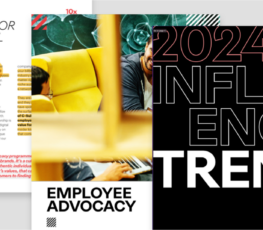The Best Employee Advocacy Statistics
Looking for valuable employee advocacy statistics? Below, you’ll find the very best stats that apply to marketing, sales, employer branding, and internal communications.
You probably have noticed more publications, companies, and even experts in marketing or sales talking more about the power of employee advocacy.
It is especially important these days as social networks have become massive centers for connecting with prospects and customers.
On top of that, 76% of individuals surveyed say that they’re more likely to trust content shared by “normal” people than content shared by brands.
At this point, your company is probably investing time and money into social media already, but a key component that is still missing for most is an employee advocacy program.
Even if you understand the concept and see the value, this somewhat new strategy can still be a hard sell to leaders and the C-suite.
Of course, the best way to prove the value of something is with solid research and stats. With that, there are also a TON of statistics out there.
Instead of giving you every random stat, we’ve compiled the very best employee advocacy statistics that will make you–or your team–realize how important this is to marketing, sales, human resources, and communications.
Feel free to jump to the sections that matter most:
- Important Social Media Statistics
- General Employee Advocacy Statistics
- Employee Advocacy Stats for Marketing
- Employee Advocacy Stats for Sales
- Employee Advocacy Stats for Employer Branding
- Employee Advocacy Stats for Communications
Important Social Media Statistics
Before we get into the specific employee advocacy statistics for marketing, sales, HR, and comms, it’s important to explore some general social media stats.
We all know how big social media platforms can be, but some of these numbers are quite eye-opening and interesting.
- Close to half the world’s population (3.03 billion people) are on some type of social media. (Statusbrew)
- Facebook still reigns as the most popular social media network with 79% of internet users in the US logging on the site. (Pew Research Center)
- In Q4 2017, Twitter estimated an average of 330 million monthly active users across the globe–a 4% increase from 2016. (Twitter)
- There are more than 800 million LinkedIn user accounts in over 200 countries. (LinkedIn)
- In 2012, the average internet user had three social media accounts–now the average is closer to seven accounts. (Globalwebindex)
- 88% of 18- to 29-year-olds indicated that they use any form of social media, 78% among those ages 30 to 49, to 64% among those ages 50 to 64 (Pew Research Center)
- People have an average of 8.6 social media accounts and spent an average of 2 hours 24 mins a day on social media (Backlinko)
- 67% of consumers surveyed say they are likely to purchase an item or service they see on their social feeds. (B2C)
- 91% of social media users access social channels through mobile. (Pew Research Center)
General Employee Advocacy Statistics
Additionally, it’s important to have some of the general employee advocacy data as well. These are just a snippet of some stats around employees on social media how an employee advocacy program can amplify results.
- 98% of employees use at least one social media site for personal use, of which 50% are already posting about their company. (Weber Shandwick)
- A recommendation from a friend or family member makes 83% of Americans more likely to purchase that product or service. (Convince & Convert)
- 58.8% of employees in a formal employee advocacy program spend more than five hours per week on social media for business use. For those in a non-formal program, however, only 31.8% spent greater than five hours online (Hinge Marketing).
- Employees who participate in a social employee advocacy program organically grow their social networks by 10%+ per year. (EveryoneSocial)
- 87.2% surveyed recognized employee advocacy contributed to expanding their professional network and 76% believed that it helped them keep up with industry trends. (Hinge Marketing)
- B2B decision-makers use thought leadership to vet a company’s capabilities. 59% agree that an organization’s thought leadership is a more trustworthy source for assessing a company’s capabilities than the company’s marketing material. (Edelman B2B Thought Leadership Study)
Employee Advocacy Statistics for Marketing
Employee advocacy programs have some of the biggest impacts on marketing, whether that is amplifying brand, driving traffic and leads, etc.
Below are some stand-out employee advocacy stats for marketing.
- Brand messages are re-shared 24 times more frequently when distributed by employees’ through employee advocacy vs the brand (Business2Community)
- 79% of firms surveyed reported more online visibility after the implementation of a formal employee advocacy program. 65% reported increased brand recognition. (Hinge Marketing)
- Content shared by employees receives 8x more engagement than content shared by brand channels. (Social Media Today)
- Leads developed through employee social marketing convert 7x more frequently than other leads. (Marketing Advisory Network)
- Earned media (press, word-of-mouth, peer-to-peer referrals) drives 4x the brand lift as paid media. (Bazaar Voice)
- Peer-to-peer marketing is the leading driver behind 20-50% of all purchasing decisions. (McKinsey)
- An employee advocacy program costs 1/10 of paid advertising (or less). (EveryoneSocial)
- On average, an employee advocacy program involving 1,000 active participants can generate $1,900,000 in advertising value. (Kredible)
Employee Advocacy Statistics for Sales
These days, salespeople need to be active on social media. It’s where prospects and customers are hanging out and researching products and services.
Employee advocacy is an important strategy for sales and generally is called social selling. The two terms are pretty interchangeable when it comes to sales.
Below are some employee advocacy/social selling statistics for sales.
- 73% of salespeople using social selling as part of their sales process outperformed their sales peers and exceeded quota 23 percent more often. (Aberdeen Group)
- According to IBM, when a lead is generated through social selling or employee advocacy that lead is 7X more likely to close compared to other lead gen tactics. (Gartner)
- Sales reps using social media as part of their sales techniques outsell 78% of their peers. (Forbes)
- 91% of B2B buyers are active on social media. (SuperOffice)
- 64% of teams that use social selling hit quota compared to 49% that don’t. (Aberdeen Group)
- 80% believe their sales force would be more effective and efficient if they could leverage social media. (Sales Management Association)
- People are 71% more likely to make a purchase based on a social media referral. (HubSpot)
- An employee advocacy program can drive 16% better win rates, 2x pipeline, and deliver 48% larger deals. (EveryoneSocial)
Employee Advocacy Statistics for Employer Branding
Generally, with employee advocacy and social selling, we think of the big impact on marketing and sales. And rightfully so if you look at those above stats.
Yet, employee advocacy also positively affects other departments in your company, like human resources. It’s a great way to attract top talent and improve retention.
Below are some employee advocacy stats related to social recruiting and employer branding.
- 79% of job applicants use social media in their job search. (Glassdoor)
- 47% of referral hires have greater job satisfaction and stay longer at companies. (Jobvite)
- Job seekers rank social media and professional networks as the most useful job search resource compared to job boards, job ads, recruiting agencies, and recruiting events. (CareerArc)
- Referrals are one of the top sources of external hires and employee advocates are perfect referrers. A recruitment campaign driven entirely by advocacy can have an on-cost that’s close to zero (Social Media Today).
- Socially engaged employees are more optimistic, inspired, connected, and tenured. (Altimeter Group)
- When asked which employee-shared content consumers found most relevant, recruiting rose to the top: 30% of consumers find job posting useful. (EveryoneSocial)
- Employee referrals have the highest applicant to hire conversion rate – only 7% of applicants are via employees but this accounts for 40% of all new hire hires. (Jobvite)
- Employees of socially engaged companies are more likely to stay at their company, feel optimistic about their company’s future and believe their company is more competitive. (Prophet)
- Companies with a successful employee advocacy program are 58% more likely to attract, and 20% more likely to retain, top talent. (LinkedIn)
- Companies with highly engaged teams have a 41% reduction in absenteeism and a 59% reduction in staff turnover. (Forbes)
Employee Advocacy Statistics for Communications
Additionally, employee advocacy also directly impacts internal communications and how employees stay connected with each other and the company leaders.
Below are some employee advocacy stats for communications teams.
- More than 80% of Americans say employee communication is key to developing trust with their employers. (Lexicon)
- 74% of employees feel they are missing out on company information and news. (Trade Press Services)
- 85% of employees said they’re most motivated when management offers regular updates on company news. (Trade Press Services)
- Use of social software by employees can improve productivity by 20-25%. (McKinsey)
- More informed employees outperform their peers by 77%. (CEB/Gartner)
- When companies use social media internally, messages become content; a searchable record of knowledge can reduce, by as much as 35%, the time employees spend searching for company information. (McKinsey)
Final Thoughts
Hopefully, these employee advocacy statistics made you raise your eyebrows in a positive way and helped prove to you how important it is for your company in the digital age.
It’s why high-growth organizations like Unity, Okta, T-Mobile, and many others have been investing in a strategy and program.
However, being that employee advocacy is still growing and somewhat new, getting buy-in or understanding why this matters can be challenging.
But if you take these key stats and other research, you’ll quickly start to gain support for social initiatives and your company will reap the benefits.
















